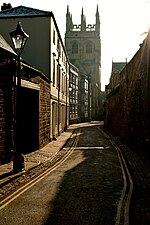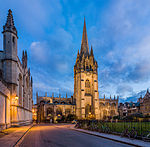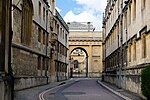Shelley Memorial
1893 establishments in England1893 sculpturesBuildings and structures of the University of OxfordCultural depictions of Percy Bysshe ShelleyCulture of the University of Oxford ... and 10 more
DomesEnglish poetryHistory of the University of OxfordIndividual roomsMarble sculptures in the United KingdomMonuments and memorials in OxfordshireSculptures in EnglandStatues of writersTourist attractions in OxfordUniversity College, Oxford

The Shelley Memorial is a memorial to the English poet Percy Bysshe Shelley (1792–1822) at University College, Oxford, England, the college that he briefly attended and from which he was expelled for writing the 1811 pamphlet "The Necessity of Atheism".Although Shelley was expelled from the college, he remains one of its most famous alumni and is now held in high honour there. In 2005, the college acquired some of Shelley's letters to further enhance its connection with the poet.
Excerpt from the Wikipedia article Shelley Memorial (License: CC BY-SA 3.0, Authors, Images).Shelley Memorial
High Street, Oxford City Centre
Geographical coordinates (GPS) Address Nearby Places Show on map
Geographical coordinates (GPS)
| Latitude | Longitude |
|---|---|
| N 51.75257 ° | E -1.25244 ° |
Address
University College
High Street
OX1 4BH Oxford, City Centre
England, United Kingdom
Open on Google Maps










